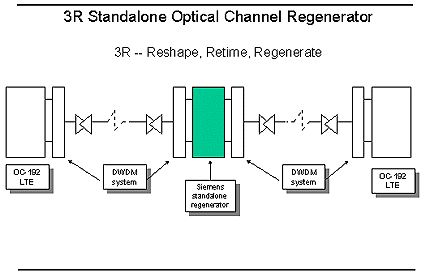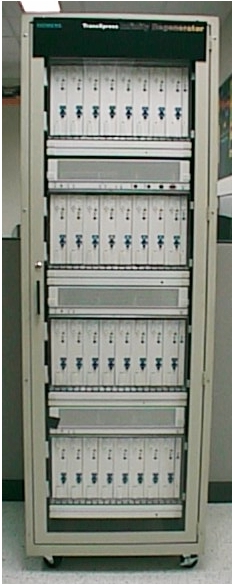Stand-Alone Regenerators Provide Economic, Performance Benefits to Long-Haul Networks
By Robert Au-Yang, Siemens Information and Communication Networks
Contents
Role of a regenerator
Transponders and 3R functions
Modular and scalable solution
Long-haul carriers operating high-speed transport networks are caught between two conflicting objectives. On the one hand, carriers must deploy scalable transmission systems to guarantee their customers the highest-possible quality of service—for both Internet protocol (IP) traffic and synchronous optical network (SONET) signals. On the other hand, carriers must reduce capital investment and operating costs to remain competitive. Carriers have often sacrificed one objective in order to achieve the other.
Advances in optical channel regenerator technology promise to deliver robust transmission at a lower cost than traditional equipment. Stand-alone optical channel regenerators enhance the power and performance of networks when and where required, at prices that fit individual business strategies.
Role of a regenerator
Regenerators restore the quality of optical signals with optical-to-electrical-to-optical conversion. The traditional SONET regenerator also terminates and regenerates all the section overhead bytes for framing and other operations, administrative, and maintenance (OAM) functions. Because of the rich set of OAM functionalities, SONET regenerators are required to have full overhead access and processing, which translates into high cost, high power consumption, and large space requirements.
As dense wavelength division multiplexing (DWDM) continues to dominate long haul networks, traditional SONET regenerators become too bulky for high channel count applications. Although new equipment now performs continent-wide transmission without regenerators, carriers will always have network routes that require signal regeneration. A low-cost, high-density optical regenerator solves the cost and space issues that carriers now endure on high channel count, long distance network routes (see Figure 1).

Figure 1: New optical regenerators perform 3R functions on 10 Gb/s signals for optically amplified WDM systems at a fraction of the cost and size of traditional SONET/SDH regenerators.
Vendors typically sell regenerators as part of an integrated network of SONET terminal equipment. By supporting standard OC-192 SONET interfaces, stand-alone optical channel regenerators interoperate with any vendor's 10 Gb/s equipment, be it a SONET terminal or a gigabit router or switch. Regenerator interoperability means that carriers no longer must depend on a single supplier for both terminal equipment and regenerators, which unleashes competition among hardware suppliers, which lowers prices for carriers.
Although a stand-alone regenerator uses a standard SONET interface, it does not necessarily need to perform full SONET demultiplexing, which accounts for a substantial amount of the cost of traditional regenerators. Stand-alone regenerators without SONET demultiplexing and less SONET-specific circuitry than traditional SONET regenerators comprise a cost-effective alternative to a complete network of SONET gear for regenerating traffic in long-haul networks, lowering overall system cost by as much as 40 percent. Having the flexibility to perform or not perform SONET demultiplexing allow carriers to obtain and pay for only the necessary capability.
Transponders and 3R functions
One regenerator application provides 3R (reshape, retime, and regenerate) signal functions in optically amplified DWDM networks. Because regenerators are traditionally integrated with SONET add/drop multiplexers (ADMs), traditional long-haul DWDM networks that require 3R inherently require entire SONET networks. By performing 3R functions without performing full SONET demultiplexing, stand-alone optical channel regenerators allow carriers to perform 3R on signals other than those from SONET ADMs, such as routers that use SONET framing. This enables a router-over-DWDM architecture that includes the 3R of a SONET network, without the need for a network of SONET regenerators and ADMs.
Another application for stand-alone optical channel regenerators is to function as a cost-effective wavelength-specific transponder for transporting IP traffic over a 10 Gb/s optical backbone. The traditional scenario for core IP transport starts with a router that delivers a SONET-framed 2.5 Gb/s signal to a 10 Gb/s SONET terminal, which subsequently interfaces with a DWDM system. Another scenario equips the router with high-performance, wavelength-specific, long-reach, 10 Gb/s optics to interface directly with the DWDM system.
Using a regenerator as a transponder provides a more cost-effective alternative to both core router scenarios. The 10 Gb/s signal comes off the router and goes into the standalone regenerator via the regenerator's standard OC-192 interface. The regenerator converts the signal to the specific wavelengths required. This scenario saves carriers the cost and complexity of using a SONET terminal to the multiplex lower-rate IP routers to 10 Gb/s, and also saves the cost burden of high-performance, wavelength-specific 10 Gb/s optics on routers.
Modular and scalable solution
Standalone regenerators also enable incremental, cost-justified growth. High density and small footprint make stand-alone optical channel regenerators a high-performance, low-cost alternative to traditional SONET regenerators. By exploiting the high-density silicon of its own application specific integrated circuit (ASIC) technology, manufacturers can reduce system size while simultaneously enhancing system performance.
With a modular architecture, a regenerator system can scale from one to 32 channels in single-channel increments. Each shelf can hold up to eight plug-in optical channel regenerators, and a carrier can link up to four shelves to obtain the full 32-channel complement in a single bay. In a typical scenario involving a bi-directional signal, a carrier initially would purchase two regenerators, then increase that number in two-unit increments, up to eight per shelf, as traffic growth demands (see Figure 2).

Figure 2: Siemens' TransXpress Infinity Regenerator houses full 4-by-4 density in a single subrack. The system's management and performance monitoring capability includes eye design measurement and Q measurement.
Standalone optical channel regenerators, by serving as both regenerators and transponders, offer carriers a flexible and cost-effective way to transport IP traffic and make the migration from circuit-switched networking to packet-switched networking more affordable. Throughout that migration process, carriers must be able to deliver guaranteed quality of service for all traffic types. Regenerators provide extensive management and performance-monitoring capabilities, such as eye measurement and Q measurement. With these capabilities, carriers can monitor the quality of signals at the SONET level and the optical level. Given their increasing reliance on WDM systems, carriers understandably demand more sophisticated tools that give them as much information as possible, at the optical level, about the quality of that optical signal. Regenerators deliver that information.
The importance of these management and performance-monitoring tools will increase in direct proportion to the number of IP-based 10-Gbps applications riding on the network. Just as they do with their transport of SONET-based signals, carriers handling an increasing amount of IP traffic must be able to evaluate end-to-end network performance continuously. By providing eye and Q measurements, standalone optical channel regenerators give carriers more information about network performance than traditional SONET regenerators. In the process, the devices enable carriers to isolate faults quickly, restore service promptly, and deliver the guaranteed quality of service their customers demand.
About the author:
Robert Au-Yang is manager of systems engineering at Siemens Information and Communication Networks Inc.
